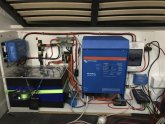I am in the process of converting my truck to an RV/tiny home and have no background in electrical. My son-in-law is an electrician and helping me out with everything, but he doesn't have experience with DC systems. So we have the whole truck wired up, and now are ready to set up the battery, inverter and solar panels.
Here is how I think things go together.
I don't know how to make schematics on the computer, so hope this is comprehensible. Thanks!!

Here is how I think things go together.
I don't know how to make schematics on the computer, so hope this is comprehensible. Thanks!!




